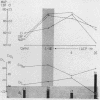Abstract
The effect of intra-aortic counterpulsation (IACP, 22-94 hr) on hemodynamics and cardiac energetics was evaluated in 10 patients in shock after acute myocardial infarction. The data clearly indicate that IACP improves myocardial oxygenation, enhances peripheral perfusion, and probably improves myocardial contractility in the severely diseased heart.
Before treatment, decreases in cardiac index (mean value, 1.22 liter/min per m2), systolic ejection rate (67 ml/sec), and time-tension index per minute (1280 mm Hg·sec/min) were observed. Systemic vascular resistance varied widely. Low coronary blood flow (68 ml/min per 100 g) was associated with increased myocardial oxygen extraction (79%), low coronary sinus oxygen tension (20 mm Hg), and abnormal myocardial lactate-pyruvate metabolism.
During 4-6 hr of IACP, systolic pressure and left ventricular outflow resistance decreased by 18% and 24%, respectively, while cardiac index improved by 38%. Diastolic arterial pressure rose 98%. Increase in coronary blood flow from an average of 68 to 91 ml/100 g per min (P < 0.001) was significantly correlated with rise in mean arterial pressure (r = 0.685). This correlation was best expressed in a third-order curve, which intercepts the point of no flow at a mean aortic pressure of 30 mm Hg. The flow-pressure curve is relatively flat above 65-70 mm Hg, but becomes steeper as mean aortic pressure falls below this point. Myocardial oxygen consumption remained essentially unchanged during early IACP and tended to rise during the later stages. However, the relationship of cardiac work performed to oxygen availability was markedly improved. Myocardial lactate production of 6% shifted to 15% extraction (P < 0.001).
After termination of IACP, hemodynamics and myocardial perfusion and metabolism remained improved in the four patients who could be reevaluated. Although the acute shock state was reversed in all patients, only one left the hospital. Extensive myocardial damage limits the long-term survival of such patients. Therefore early IACP seems desirable, when subtle evidence of pump failure after acute myocardial infarction occurs. Early use of IACP may prevent the development of severe coronary shock or may stabilize cardiac energetics in severe shock facilitating subsequent surgical intervention.
Full text
PDF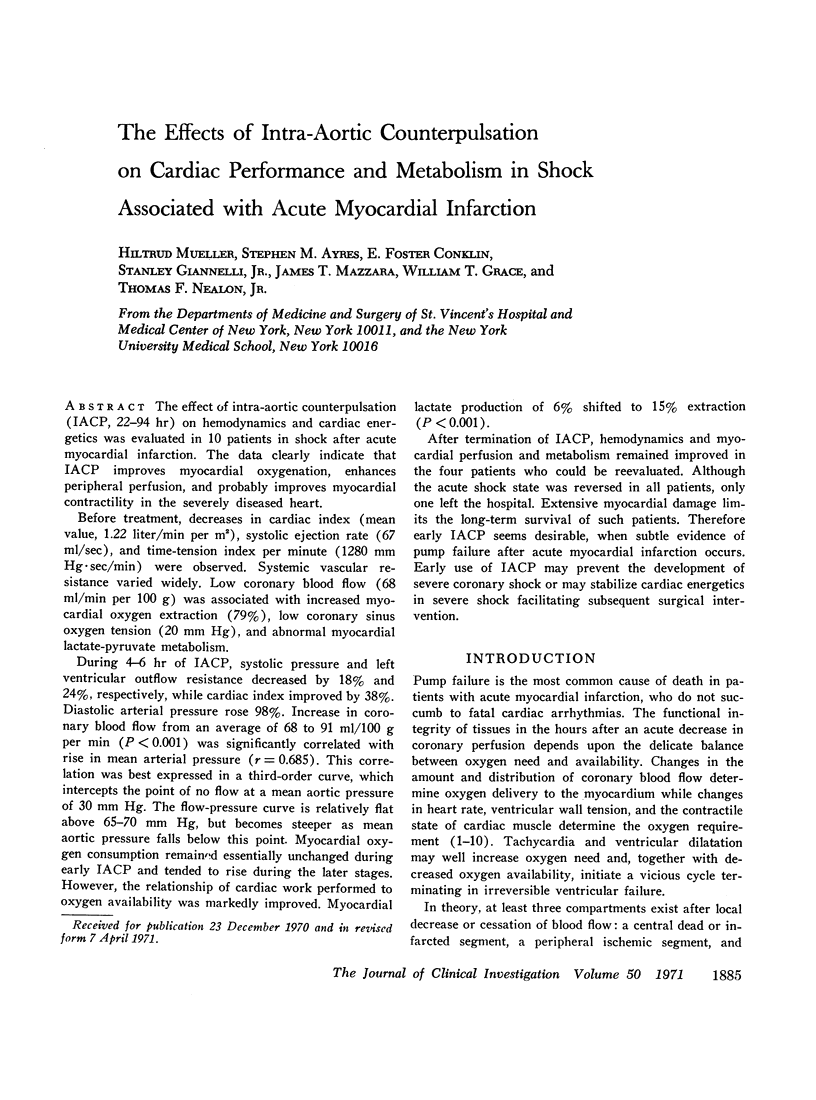
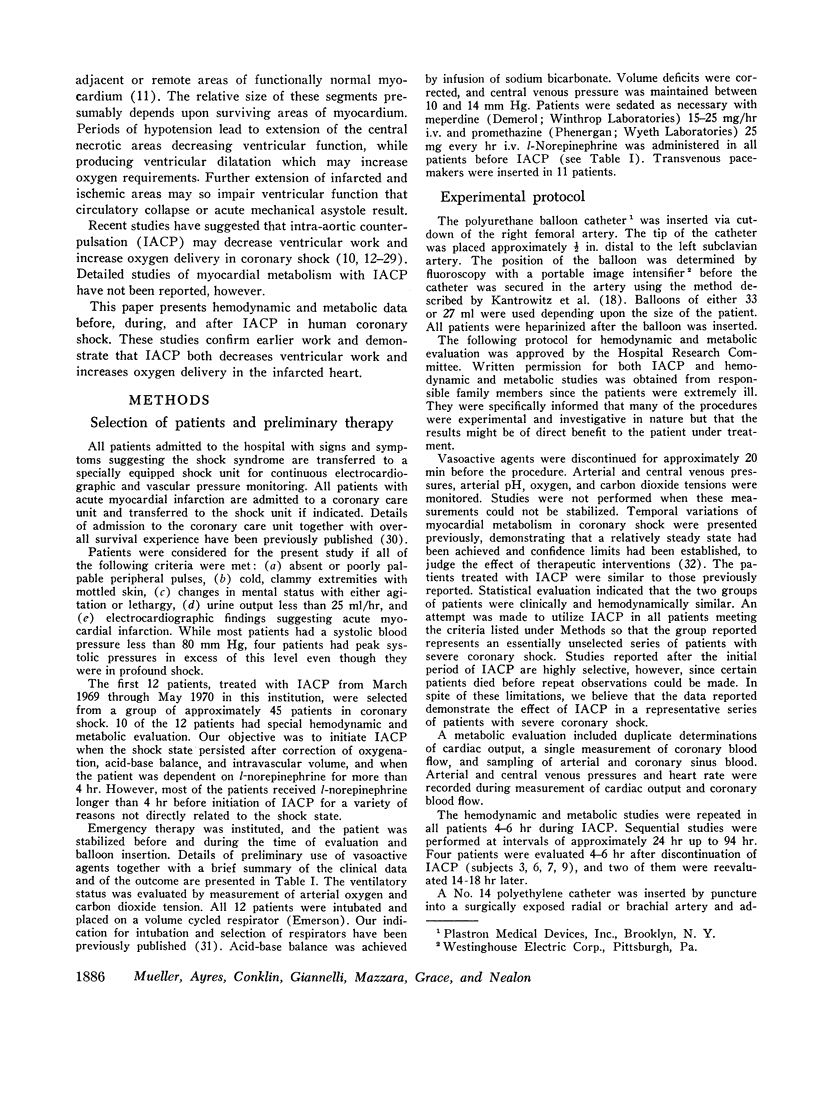
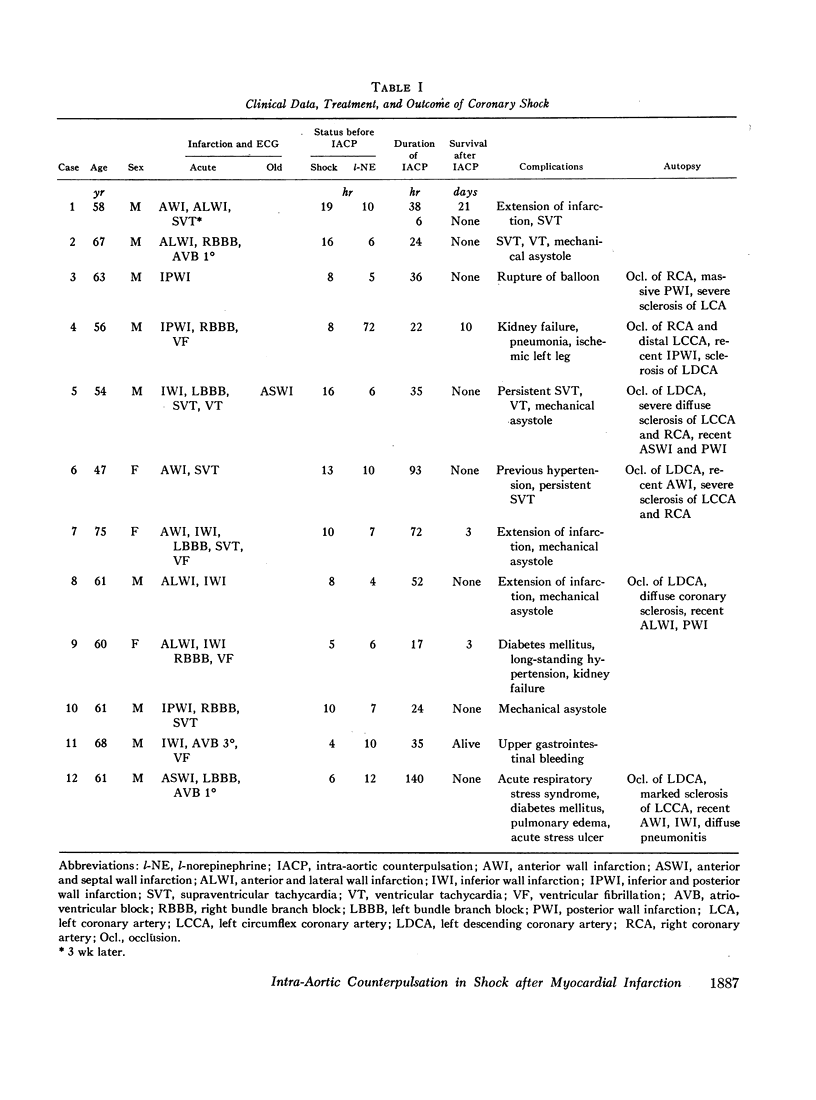
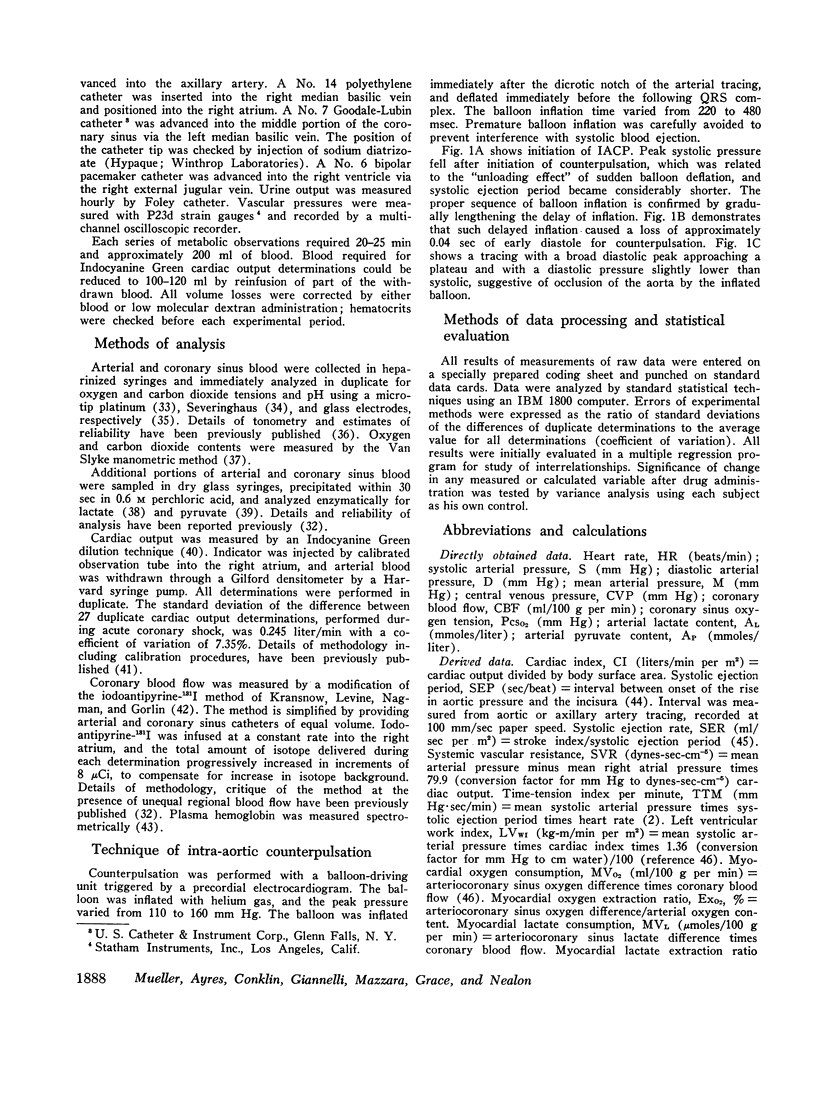
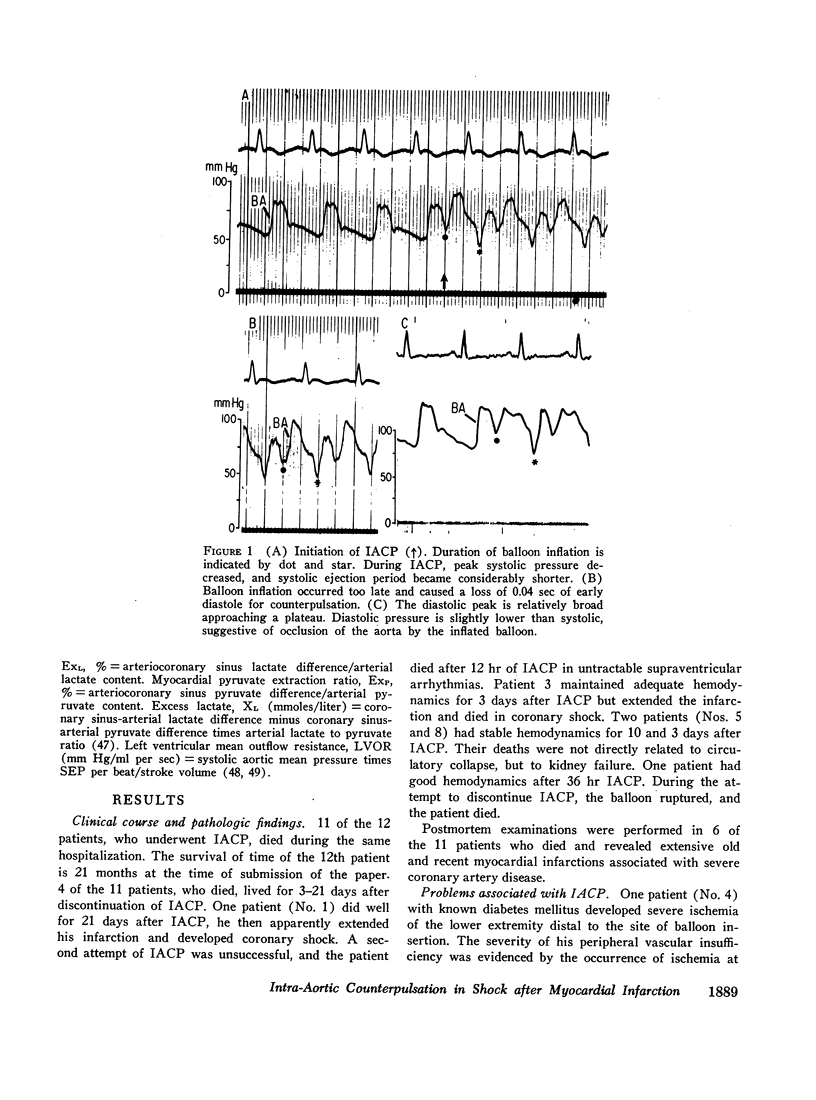
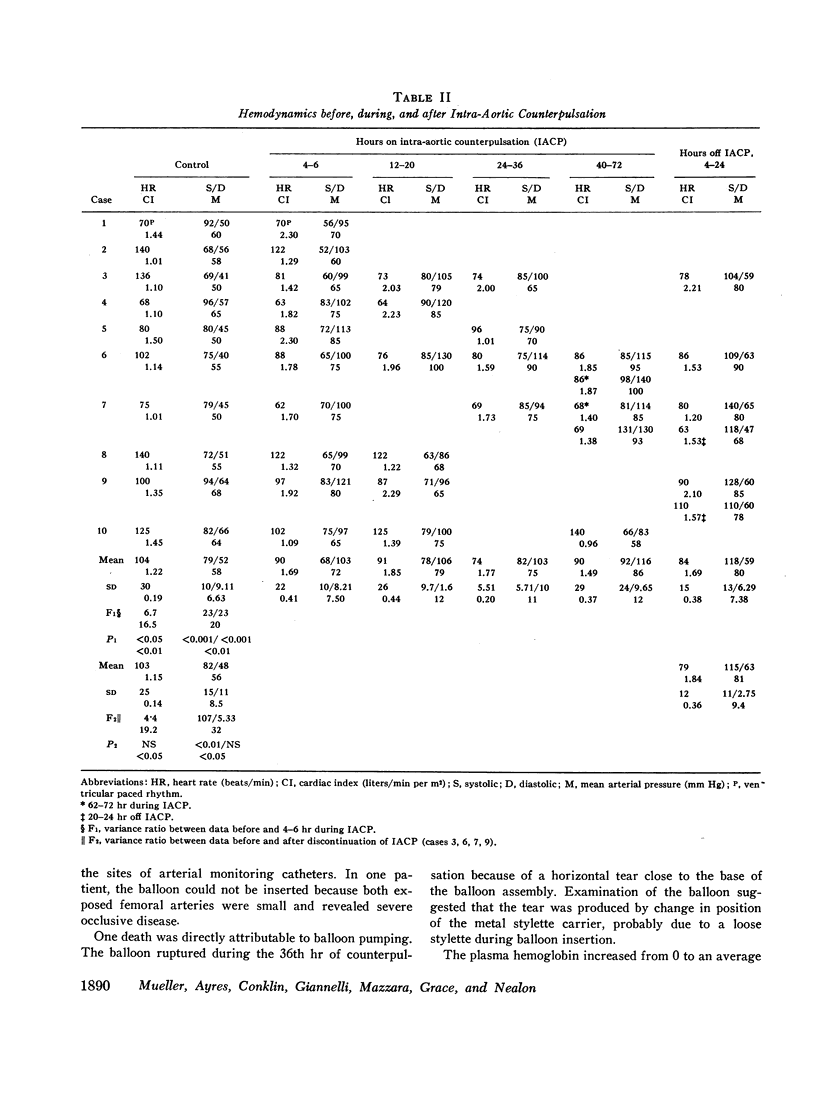
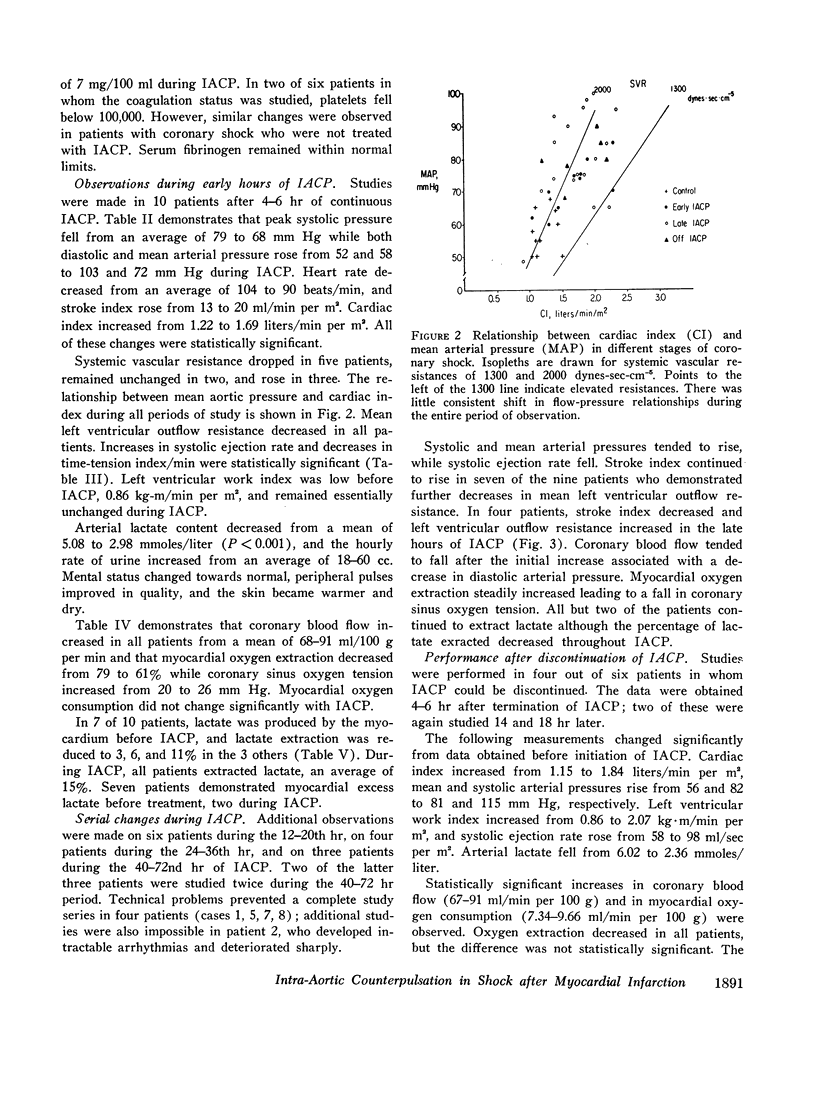
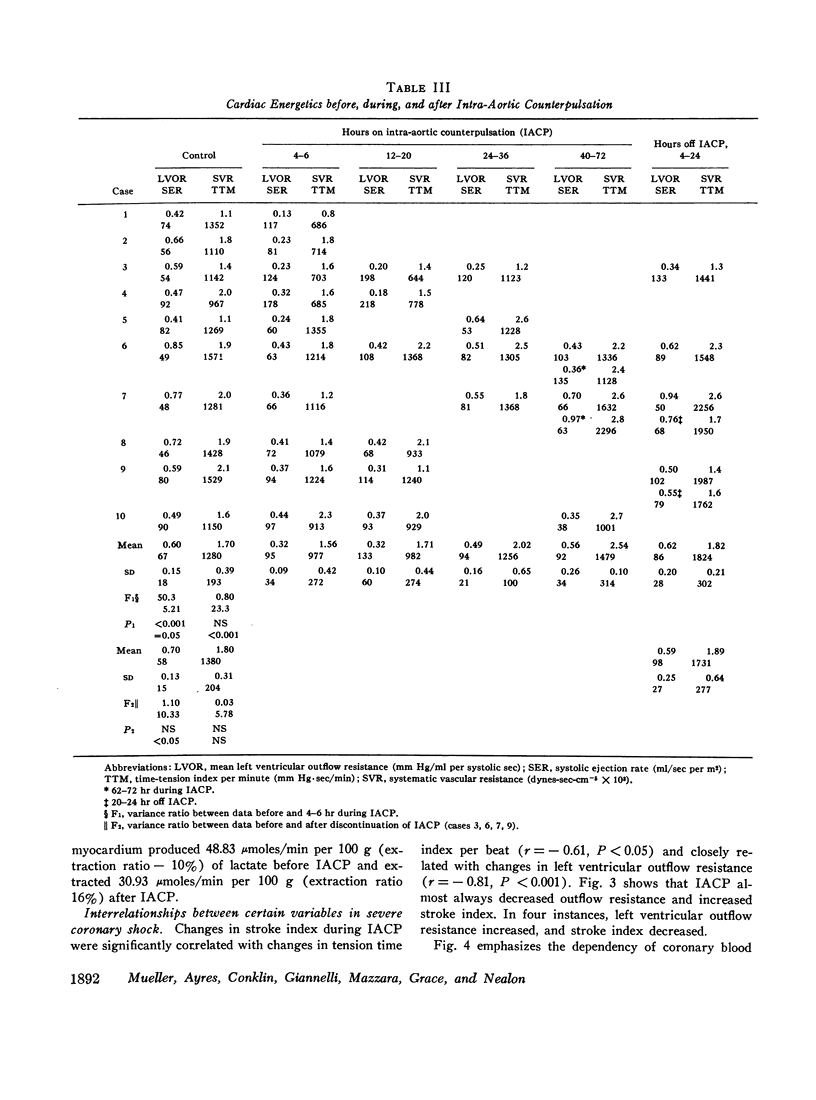
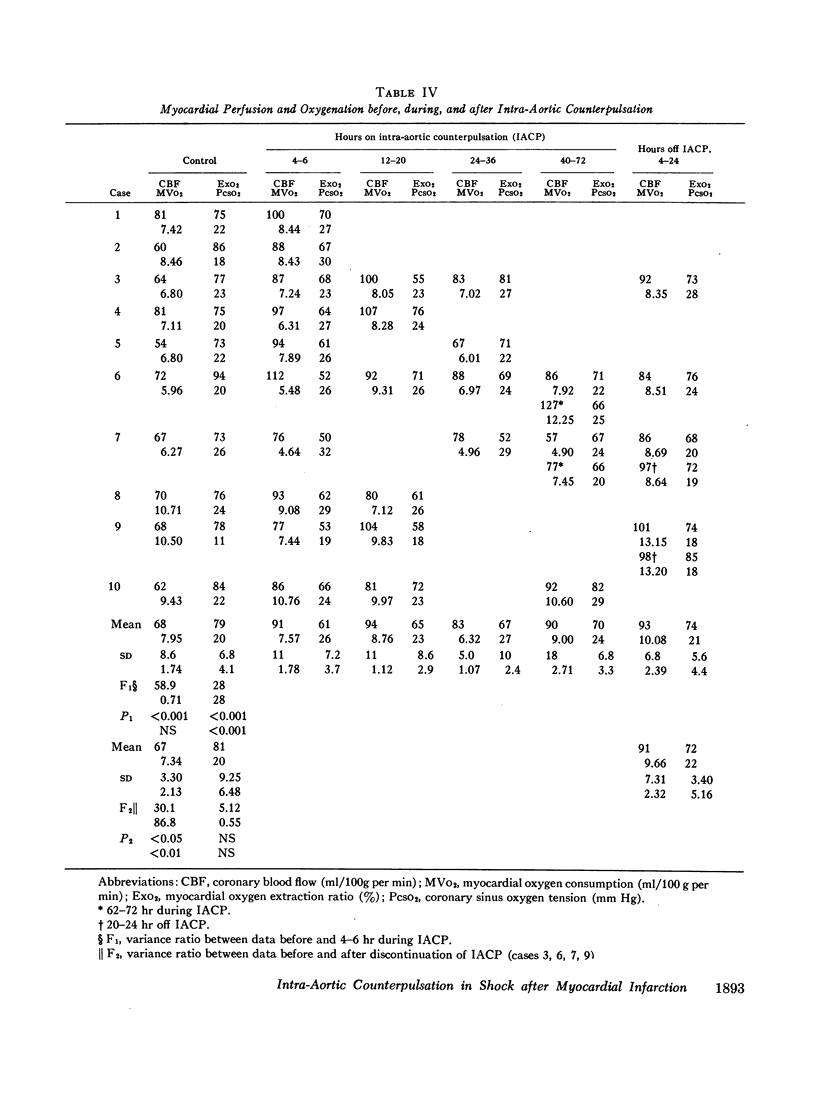

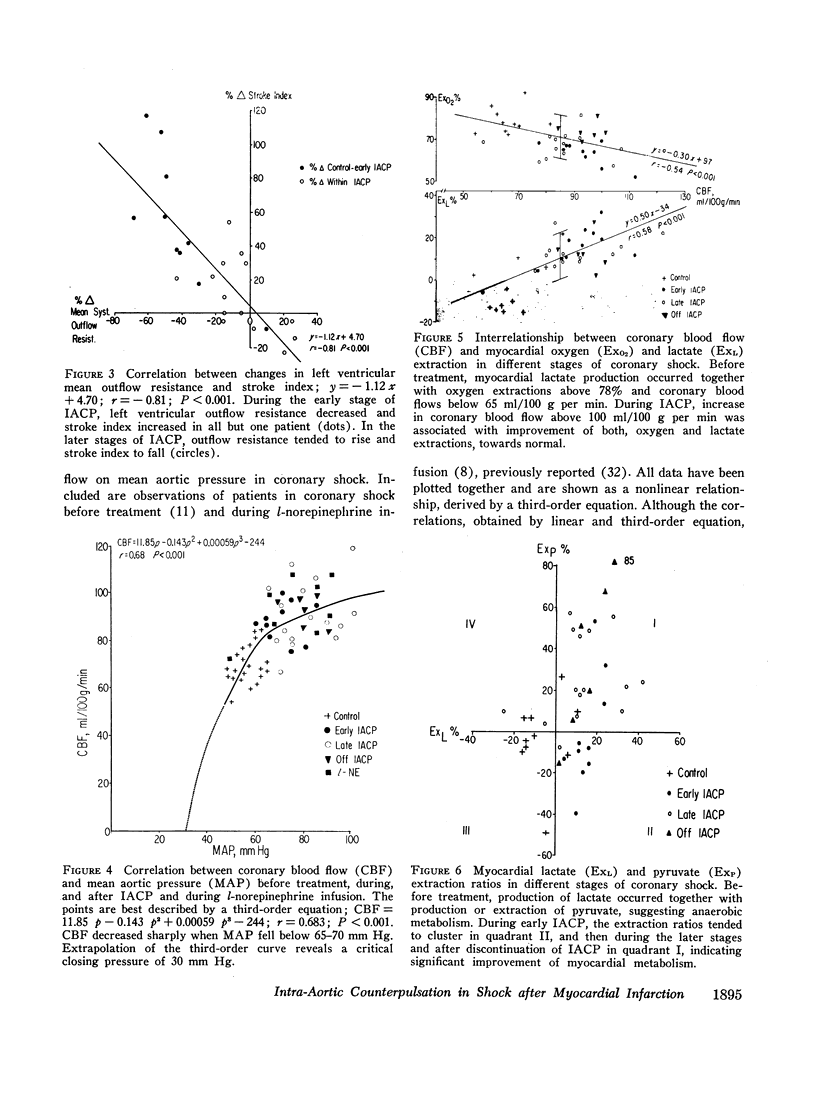
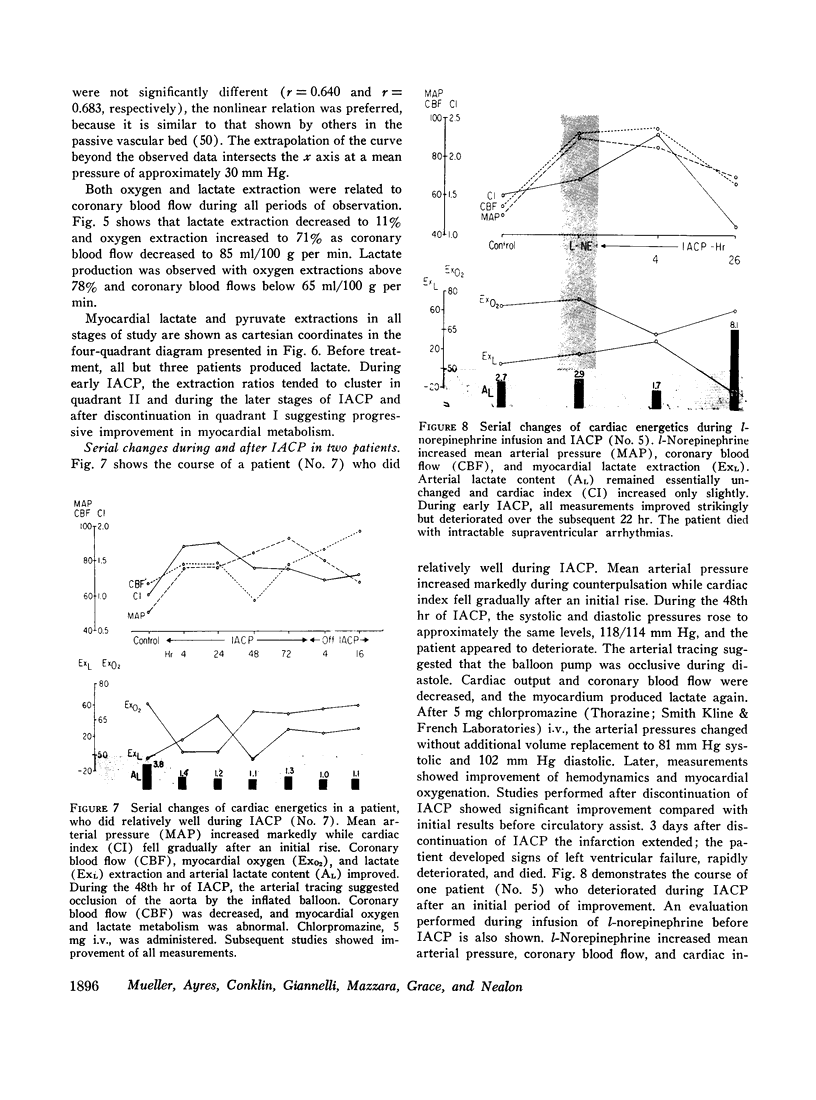
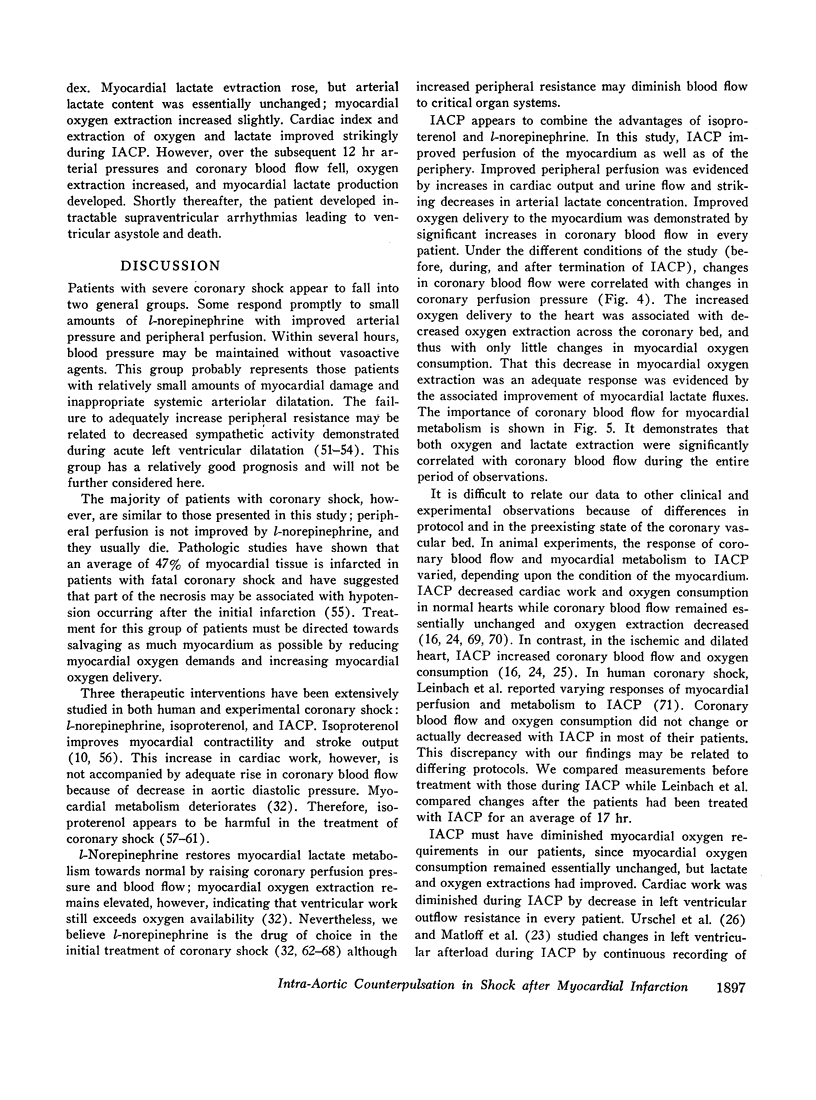
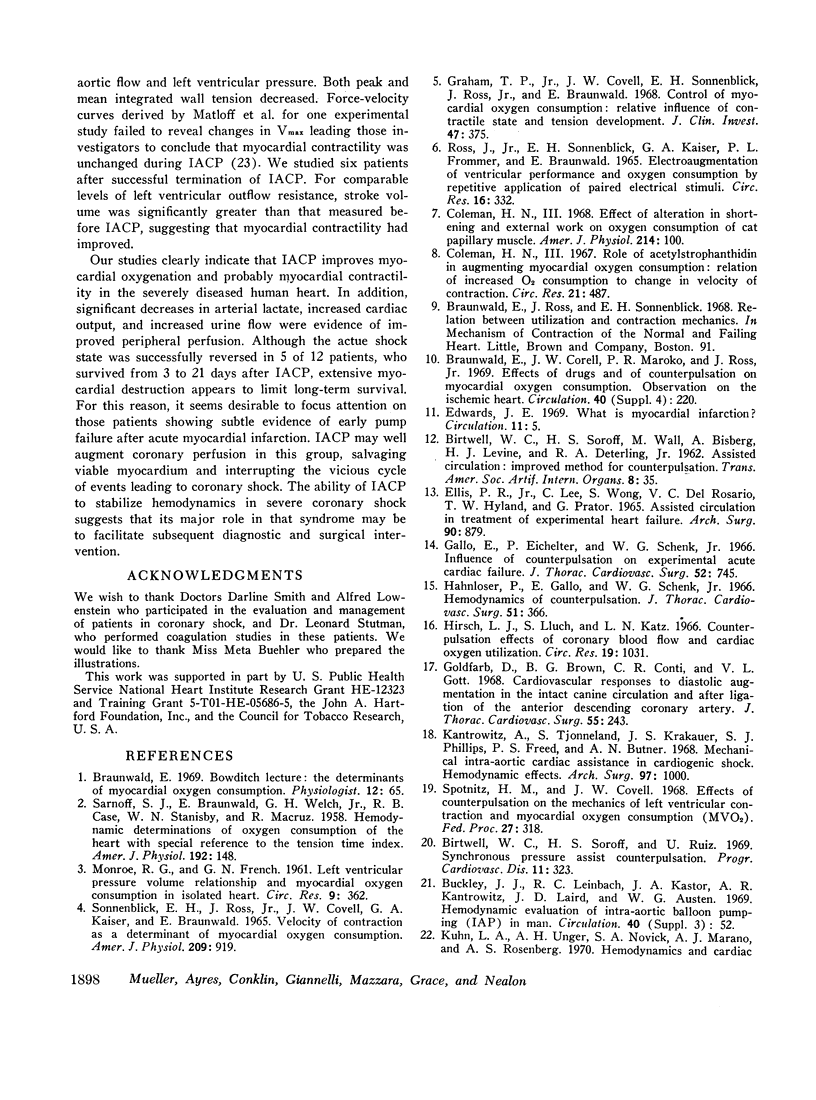
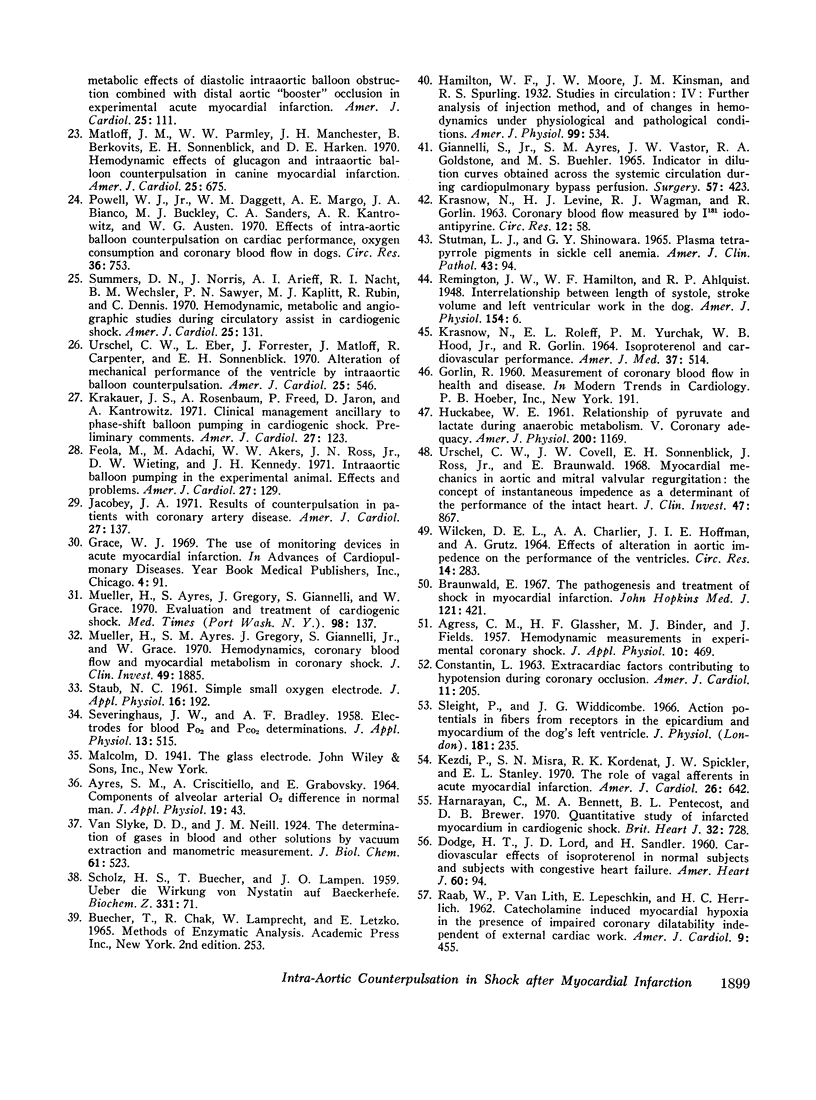
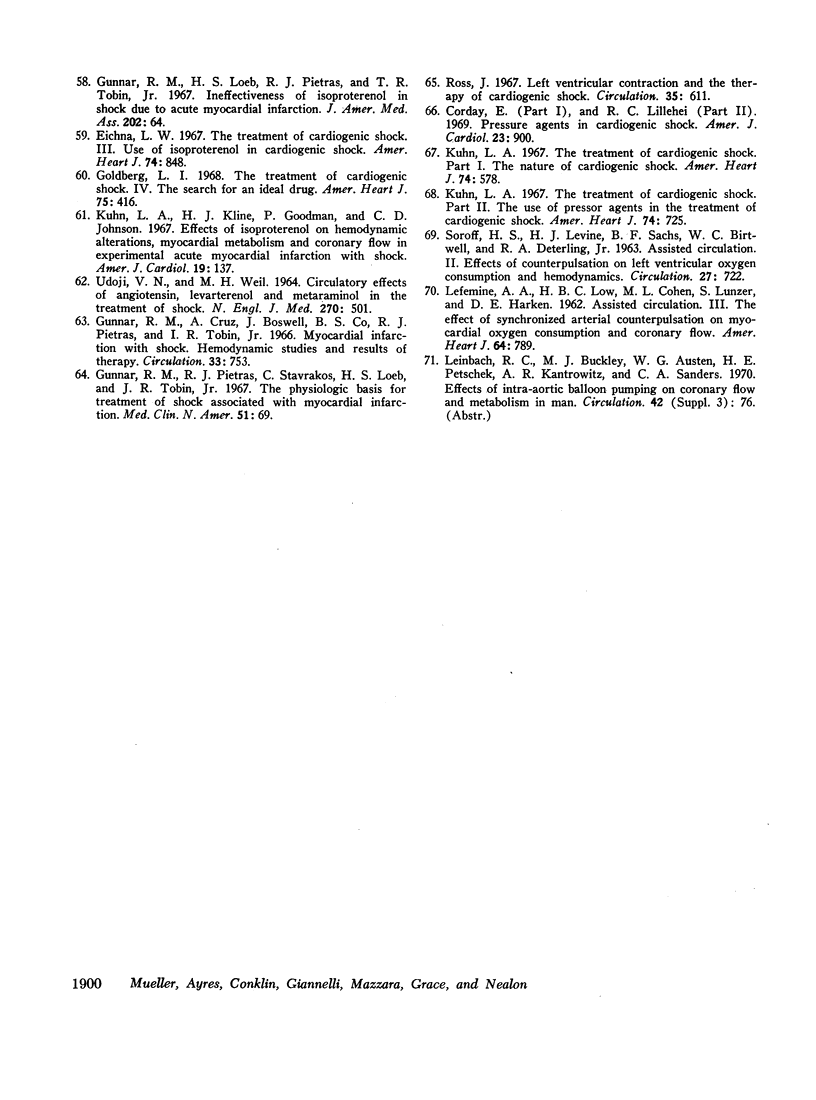
Images in this article
Selected References
These references are in PubMed. This may not be the complete list of references from this article.
- AGRESS C. M., GLASSNER H. F., BINDER M. J., FIELDS J. Hemodynamic measurements in experimental coronary shock. J Appl Physiol. 1957 May;10(3):469–475. doi: 10.1152/jappl.1957.10.3.469. [DOI] [PubMed] [Google Scholar]
- AYRES S. M., CRISCITIELLO A., GRABOVSKY E. COMPONENTS OF ALVEOLAR-ARTERIAL O2 DIFFERENCE IN NORMAL MAN. J Appl Physiol. 1964 Jan;19:43–47. doi: 10.1152/jappl.1964.19.1.43. [DOI] [PubMed] [Google Scholar]
- BIRTWELL W. C., SOROFF H. S., WALL M., BISBERG A., LEVINE H. J., DETERLING R. A., Jr Assisted circulation. I. An improved method for counterpulsation. Trans Am Soc Artif Intern Organs. 1962;8:35–42. [PubMed] [Google Scholar]
- Birtwell W. C., Soroff H. S., Ruiz U., Many M., Giron F., Deterling R. A., Jr Synchronous pressure assist-counterpulsation. Prog Cardiovasc Dis. 1969 Jan;11(4):323–337. doi: 10.1016/0033-0620(69)90058-9. [DOI] [PubMed] [Google Scholar]
- Braunwald E. Thirteenth Bowditch lecture. The determinants of myocardial oxygen consumption. Physiologist. 1969 May;12(2):65–93. [PubMed] [Google Scholar]
- Braunwald E. Topics in clinical medicine. The pathogenesis and treatment of shock in myocardial infarction. Johns Hopkins Med J. 1967 Dec;121(6):421–429. [PubMed] [Google Scholar]
- COSTANTIN L. Extracardiac factors contributing to hypotension during coronary occlusion. Am J Cardiol. 1963 Feb;11:205–217. doi: 10.1016/0002-9149(63)90062-6. [DOI] [PubMed] [Google Scholar]
- Coleman H. N., 3rd Role of acetylstrophanthidin in augmenting myocardial oxygen consumption. Relation of increased O-2 consumption to changes in velocity of contraction. Circ Res. 1967 Oct;21(4):487–495. doi: 10.1161/01.res.21.4.487. [DOI] [PubMed] [Google Scholar]
- Coleman H. N. Effect of alterations in shortening and external work on oxygen consumption of cat papillary muscle. Am J Physiol. 1968 Jan;214(1):100–106. doi: 10.1152/ajplegacy.1968.214.1.100. [DOI] [PubMed] [Google Scholar]
- Corday E., Lillehei R. C. Pressor agents in cardiogenic shock. Am J Cardiol. 1969 Jun;23(6):900–910. doi: 10.1016/0002-9149(69)90389-0. [DOI] [PubMed] [Google Scholar]
- DODGE H. T., LORD J. D., SANDLER H. Cardiovascular effects of isoproterenol in normal subjects and subjects with congestive heart failure. Am Heart J. 1960 Jul;60:94–105. doi: 10.1016/0002-8703(60)90063-6. [DOI] [PubMed] [Google Scholar]
- ELLIS P. R., Jr, LEE C., WONG S. H., DELROSARIO V. C., HYLAND J. W., PRATOR G. ASSISTED CIRCULATION IN TREATMENT OF EXPERIMENTAL HEART FAILURE. Arch Surg. 1965 Jun;90:879–889. doi: 10.1001/archsurg.1965.01320120081006. [DOI] [PubMed] [Google Scholar]
- Feola M., Adachi M., Akers W. W., Ross J. N., Jr, Wieting D. W., Kennedy J. H. Intraaortic balloon pumping in the experimental animal. Effects and problems. Am J Cardiol. 1971 Feb;27(2):129–136. doi: 10.1016/0002-9149(71)90249-9. [DOI] [PubMed] [Google Scholar]
- GIANNELLI S., Jr, AYRES S. M., VASTOLA J. W., GOLDSTONE R. A., BUEHLER M. E. INDICATOR-DILUTION CURVES OBTAINED ACROSS THE SYSTEMIC CIRCULATION DURING CARDIOPULMONARY BYPASS PERFUSION. Surgery. 1965 Mar;57:423–434. [PubMed] [Google Scholar]
- Gallo E., Eichelter P., Schenk W. G., Jr Influence of counterpulsation on experimental acute cardiac failure. J Thorac Cardiovasc Surg. 1966 Nov;52(5):745–754. [PubMed] [Google Scholar]
- Goldberg L. I. The treatment of cardiogenic shock. VI. The search for an ideal drug. Am Heart J. 1968 Mar;75(3):416–420. doi: 10.1016/0002-8703(68)90098-7. [DOI] [PubMed] [Google Scholar]
- Goldfarb D., Brown B. G., Conti C. R., Gott V. L. Cardiovascular responses to diastolic augmentation in he intact canine circulation and after ligation of the anterior descending coronary artery. J Thorac Cardiovasc Surg. 1968 Feb;55(2):243–254. [PubMed] [Google Scholar]
- Graham T. P., Jr, Covell J. W., Sonnenblick E. H., Ross J., Jr, Braunwald E. Control of myocardial oxygen consumption: relative influence of contractile state and tension development. J Clin Invest. 1968 Feb;47(2):375–385. doi: 10.1172/JCI105734. [DOI] [PMC free article] [PubMed] [Google Scholar]
- Gunnar R. M., Cruz A., Boswell J., Co B. S., Pietras R. J., Tobin J. R., Jr Myocardial infarction with shock. Hemodynamic studies and results of therapy. Circulation. 1966 May;33(5):753–762. doi: 10.1161/01.cir.33.5.753. [DOI] [PubMed] [Google Scholar]
- Gunnar R. M., Pietras R. J., Stavrakos C., Loeb H. S., Tobin J. R., Jr The physiologic basis for treatment of shock associated with myocardial infarction. Med Clin North Am. 1967 Jan;51(1):69–81. doi: 10.1016/s0025-7125(16)33083-8. [DOI] [PubMed] [Google Scholar]
- HUCKABEE W. E. Relationship of pyruvate and lactate during anaerobic metabolism. V. Coronary adequacy. Am J Physiol. 1961 Jun;200:1169–1176. doi: 10.1152/ajplegacy.1961.200.6.1169. [DOI] [PubMed] [Google Scholar]
- Hahnloser P. B., Schenk W. G., Jr, Gallo E. The hemodynamics of counterpulsation. J Thorac Cardiovasc Surg. 1966 Mar;51(3):366–378. [PubMed] [Google Scholar]
- Harnarayan C., Bennett M. A., Pentecost B. L., Brewer D. B. Quantitative study of infarcted myocardium in cardiogenic shock. Br Heart J. 1970 Nov;32(6):728–732. doi: 10.1136/hrt.32.6.728. [DOI] [PMC free article] [PubMed] [Google Scholar]
- Hirsch L. J., Lluch S., Katz L. N. Counterpulsation effects of coronary blood flow and cardiac oxygen utilization. Circ Res. 1966 Dec;19(6):1031–1040. doi: 10.1161/01.res.19.6.1031. [DOI] [PubMed] [Google Scholar]
- Jacobey J. A. Results of counterpulsation in patients with coronary artery disease. Am J Cardiol. 1971 Feb;27(2):137–145. doi: 10.1016/0002-9149(71)90250-5. [DOI] [PubMed] [Google Scholar]
- KRASNOW N., LEVINE H. J., WAGMAN R. J., GORLIN R. Coronary blood flow measured by I-131 iodo-antipyrine. Circ Res. 1963 Jan;12:58–62. doi: 10.1161/01.res.12.1.58. [DOI] [PubMed] [Google Scholar]
- KRASNOW N., ROLETT E. L., YURCHAK P. M., HOOD W. B., Jr, GORLIN R. ISOPROTERENOL AND CARDIOVASCULAR PERFORMANCE. Am J Med. 1964 Oct;37:514–525. doi: 10.1016/0002-9343(64)90065-8. [DOI] [PubMed] [Google Scholar]
- Kantrowitz A., Tjonneland S., Krakauer J. S., Phillips S. J., Freed P. S., Butner A. N. Mechanical intraaortic cardiac assistance in cardiogenic shock. Hemodynamic effects. Arch Surg. 1968 Dec;97(6):1000–1004. doi: 10.1001/archsurg.1968.01340060178021. [DOI] [PubMed] [Google Scholar]
- Krakauer J. S., Rosenbaum A., Freed P. S., Jaron D., Kantrowitz A. Clinical management ancillary to phase-shift balloon pumping in cardiogenic shock. Preliminary comments. Am J Cardiol. 1971 Feb;27(2):123–128. doi: 10.1016/0002-9149(71)90248-7. [DOI] [PubMed] [Google Scholar]
- Kuhn L. A. The treatment of cardiogenic shock. I. The nature of cardiogenic shock. Am Heart J. 1967 Oct;74(4):578–581. doi: 10.1016/0002-8703(67)90019-1. [DOI] [PubMed] [Google Scholar]
- Kuhn L. A. The treatment of cardiogenic shock. II. The use of pressor agents in the treatment of cardiogenic shock. Am Heart J. 1967 Nov;74(5):725–728. doi: 10.1016/0002-8703(67)90511-x. [DOI] [PubMed] [Google Scholar]
- LEFEMINE A. A., LOW H. B., COHEN M. L., LUNZER S., HARKEN D. E. Assisted circulation. III. The effect of synchronized arterial counterpulsation on myocardial oxygen consumption and coronary flow. Am Heart J. 1962 Dec;64:789–795. doi: 10.1016/0002-8703(62)90177-1. [DOI] [PubMed] [Google Scholar]
- MONROE R. G., FRENCH G. N. Left ventricular pressure-volume relationships and myocardial oxygen consumption in the isolated heart. Circ Res. 1961 Mar;9:362–374. doi: 10.1161/01.res.9.2.362. [DOI] [PubMed] [Google Scholar]
- Matloff J. M., Parmley W. W., Manchester J. H., Berkovits B., Sonnenblick E. H., Harken D. E. Hemodynamic effects of glucagon and intraaortic balloon counterpulsation in canine myocardial infarction. Am J Cardiol. 1970 Jun;25(6):675–682. doi: 10.1016/0002-9149(70)90618-1. [DOI] [PubMed] [Google Scholar]
- Mueller H. S., Ayres S. M., Gregory J. J., Giannelli S., Jr, Grace W. J. The evaluation and treatment of cardiogenic shock. Med Times. 1970 Jul;98(7):137–152. [PubMed] [Google Scholar]
- Mueller H., Ayres S. M., Gregory J. J., Giannelli S., Jr, Grace W. J. Hemodynamics, coronary blood flow, and myocardial metabolism in coronary shock; response of 1-norepinephrine and isoproterenol. J Clin Invest. 1970 Oct;49(10):1885–1902. doi: 10.1172/JCI106408. [DOI] [PMC free article] [PubMed] [Google Scholar]
- Powell W. J., Jr, Daggett W. M., Magro A. E., Bianco J. A., Buckley M. J., Sanders C. A., Kantrowitz A. R., Austen W. G. Effects of intra-aortic balloon counterpulsation on cardiac performance, oxygen consumption, and coronary blood flow in dogs. Circ Res. 1970 Jun;26(6):753–764. doi: 10.1161/01.res.26.6.753. [DOI] [PubMed] [Google Scholar]
- RAAB W., VAN LITH P., LEPESCHKIN E., HERRLICH H. C. Catecholamine-induced myocardial hypoxia in the presence of impaired coronary dilatability independent of external cardiac work. Am J Cardiol. 1962 Mar;9:455–470. doi: 10.1016/0002-9149(62)90163-7. [DOI] [PubMed] [Google Scholar]
- ROSS J., Jr, SONNENBLICK E. H., KAISER G. A., FROMMER P. L., BRAUNWALD E. ELECTROAUGMENTATION OF VENTRICULAR PERFORMANCE AND OXYGEN CONSUMPTION BY REPETITIVE APPLICATION OF PAIRED ELECTRICAL STIMULI. Circ Res. 1965 Apr;16:332–342. doi: 10.1161/01.res.16.4.332. [DOI] [PubMed] [Google Scholar]
- Ross J., Jr Left ventricular contraction and the therapy of cardiogenic shock. Circulation. 1967 Apr;35(4):611–613. doi: 10.1161/01.cir.35.4.611. [DOI] [PubMed] [Google Scholar]
- SARNOFF S. J., BRAUNWALD E., WELCH G. H., Jr, CASE R. B., STAINSBY W. N., MACRUZ R. Hemodynamic determinants of oxygen consumption of the heart with special reference to the tension-time index. Am J Physiol. 1958 Jan;192(1):148–156. doi: 10.1152/ajplegacy.1957.192.1.148. [DOI] [PubMed] [Google Scholar]
- SEVERINGHAUS J. W., BRADLEY A. F. Electrodes for blood pO2 and pCO2 determination. J Appl Physiol. 1958 Nov;13(3):515–520. doi: 10.1152/jappl.1958.13.3.515. [DOI] [PubMed] [Google Scholar]
- STUTMAN L. J., SHINOWARA G. Y. PLASMA TETRAPYRROLE PIGMENTS IN SICKLE CELL ANEMIA; LONG TERM STUDIES AND THE EFFECTS OF LOW TEMPERATURES. Am J Clin Pathol. 1965 Feb;43:94–103. doi: 10.1093/ajcp/43.2.94. [DOI] [PubMed] [Google Scholar]
- Sleight P., Widdicombe J. G. Action potentials in fibres from receptors in the epicardium and myocardium of the dog's left ventricle. J Physiol. 1965 Nov;181(2):235–258. doi: 10.1113/jphysiol.1965.sp007758. [DOI] [PMC free article] [PubMed] [Google Scholar]
- Sonnenblick E. H., Ross J., Jr, Covell J. W., Kaiser G. A., Braunwald E. Velocity of contraction as a determinant of myocardial oxygen consumption. Am J Physiol. 1965 Nov;209(5):919–927. doi: 10.1152/ajplegacy.1965.209.5.919. [DOI] [PubMed] [Google Scholar]
- UDHOJI V. N., WEIL M. H. CIRCULATORY EFFECTS OF ANGIOTENSIN, LEVARTERENOL AND METARAMINOL IN THE TREATMENT OF SHOCK. N Engl J Med. 1964 Mar 5;270:501–505. doi: 10.1056/NEJM196403052701004. [DOI] [PubMed] [Google Scholar]
- Urschel C. W., Covell J. W., Sonnenblick E. H., Ross J., Jr, Braunwald E. Myocardial mechanics in aortic and mitral valvular regurgitation: the concept of instantaneous impedance as a determinant of the performance of the intact heart. J Clin Invest. 1968 Apr;47(4):867–883. doi: 10.1172/JCI105780. [DOI] [PMC free article] [PubMed] [Google Scholar]
- Urschel C. W., Eber L., Forrester J., Matloff J., Carpenter R., Sonnenblick E. Alteration of mechanical performance of the ventricle by intraaortic balloon counterpulsation. Am J Cardiol. 1970 May;25(5):546–551. doi: 10.1016/0002-9149(70)90593-x. [DOI] [PubMed] [Google Scholar]
- WILCKEN D. E., CHARLIER A. A., HOFFMAN J. I., GUZ A. EFFECTS OF ALTERATIONS IN AORTIC IMPEDANCE ON THE PERFORMANCE OF THE VENTRICLES. Circ Res. 1964 Apr;14:283–293. doi: 10.1161/01.res.14.4.283. [DOI] [PubMed] [Google Scholar]




